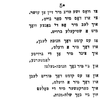2: Folksong excerpt, from Shloyme Bastomski’s "Baym Kval," 1923, Yiddish and English translation.
Shloyme Bastomski (1891–1941), was a Yiddish pedagogue, folklorist, writer, and editor. A teacher for the first secular Jewish boys’ school in Vilna, he pioneered pedagogy for Yiddish secular schools and published children’s journals and learning materials. Among his pedagogical aims was to teach Yiddish folklore as a central component of Yiddish secular culture. To this end, Bastomski collected and analyzed proverbs and other folk materials and included previously uncollected folklore materials in his pedagogical texts. His journals for children were read in Yiddish schools throughout the world.
This excerpt of an untitled folk song can be found in Bastomski’s collection of Yiddish folk songs from Lithuania, Baym Kval (At the Wellspring).
Suggested Activity: Ask your students to characterize the mood of these lyrics—is the speaker carefree? Is he complaining about his precarious economic position? What does this song tell you about the economic structure of his society and the extent to which the community acts as a social safety net?
What do Purim and Hanukkah seem to represent for this speaker? How does this differ from your students’ experiences or impressions of these holidays, or of other holidays they celebrate? If your students are already familiar with Jewish holidays and practices, have them create a Venn diagram comparing shalekh-manes (in Hebrew mishloach manot, Purim holiday gifts) and Hanukkah gelt: Who gives the gift? Who receives it? Is there a written tradition to support the gift giving? What does the gift consist of? Students may wish to consult this article from MyJewishLearning.org as a reference on the Purim tradition.
Source: S. Bastomski, Materialn tsum yidishn folklor-folkslider (At the Source: Materials on Yiddish Folklore and Folk Songs) (Vilna: Farlag Naye Yidishe Folkshul, 1923), 92. Unpublished translation by Jessica Kirzane.
Folksong_in_Yiddish.png
 Download image (54.35 KB)
Download image (54.35 KB)

